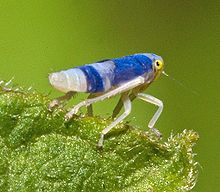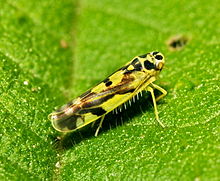- Leafhopper
-
Leafhoppers 
Adult two-lined gum treehopper (Eurymeloides bicincta: Eurymelinae) demonstrating a symbiotic relationship with meat ants Scientific classification Kingdom: Animalia Phylum: Arthropoda Class: Insecta Order: Hemiptera Suborder: Clypeorrhyncha Superfamily: Membracoidea Family: Cicadellidae
Latreille, 1802Subfamilies Almost 40, see text
Leafhopper is a common name applied to any species from the family Cicadellidae. Leafhoppers, colloquially known as hoppers, are minute plant-feeding insects in the superfamily Membracoidea in the order Hemiptera. They belong to a lineage traditionally treated as infraorder Cicadomorpha in the suborder Auchenorrhyncha, but as the latter taxon is probably not monophyletic, many modern authors prefer to abolish the Auchenorrhyncha and elevate the cicadomorphs to a suborder Clypeorrhyncha.
Leafhoppers are found all over the world, and constitute the second-largest hemipteran family. They have at least 20,000 described species. The tribe Proconiini of the subfamily Cicadellinae is commonly known as sharpshooters.
Contents
Description and ecology
The Cicadellidae combine the following features:
- The thickened part of the antennae is very short and ends with a bristle (arista).
- Two ocelli (simple eyes) are present on the top or front of the head.
- The tarsi are made of three segments.
- The femora are at front with, at most, weak spines.
- The hind tibiae have one or more distinct keels, with a row of movable spines on each, sometimes on enlarged bases.
- The base of the middle legs is close together where they originate under the thorax.
- The front wings not particularly thickened.
An additional and unique character of leafhoppers is the production of brochosomes, which are thought to protect the animals, and particularly their egg clutches, from predation and pathogens.
 Nymph of an unidentified Typhlocybinae species
Nymph of an unidentified Typhlocybinae species
Like other Exopterygota, the leafhoppers undergo direct development from nymph to adult without a pupal stage. While many leafhoppers are drab little insects as is typical for the Membracoidea, the adults and nymphs of some species are quite colorful. Some – in particular Stegelytrinae – have largely translucent wings and resemble flies at a casual glance.
Leafhoppers have piercing-sucking mouthparts, enabling them to feed on plant sap. A leafhoppers' diet commonly consists of sap from a wide and diverse range of plants, but some are more host-specific. Leafhoppers mainly are herbivores, but some are known to eat smaller insects, such as aphids, on occasion. A few species are known to be mud-puddling, but as it seems, females rarely engage in such behavior. Leafhoppers can transmit plant pathogens, such as viruses, phytoplasmas[1] and bacteria. Cicadellidae species that are significant agricultural pests include the beet leafhopper (Circulifer tenellus), potato leafhopper (Empoasca fabae), two-spotted leafhopper (Sophonia rufofascia), glassy-winged sharpshooter (Homalodisca vitripennis), the common brown leafhopper (Orosius orientalis), the Maize streak virus vector Cicadulina mbila, and the white apple leafhopper (Typhlocyba pomaria).
In some cases, the plant pathogens distributed by leafhoppers are also pathogens of the insects themselves, and can replicate within the leafhoppers' salivary glands. Leafhoppers are also susceptible to various insect pathogens, including Dicistroviridae viruses, bacteria and fungi; numerous parasitoids attack the eggs and the adults provide food for small insectivores.
Systematics
In the now-obsolete classification that was used throughout much of the 20th century, the leafhoppers were part of the Homoptera", a paraphyletic assemblage uniting the less advanced lineages of Hemiptera and ranked as suborder. The splitting of the "Homoptera is likely to be repeated for the Auchenorrhyncha for similar reasons, as the Auchenorrhyncha simply seem to group the moderately advanced Hemiptera, regardless of the fact the highly apomorphic Coleorrhyncha and Heteroptera (typical bugs) evolved from auchenorrhynchans. Hence, there is a recent trend to treat the most advanced hemipterans as three or four lineages, namely Archaeorrhyncha (Fulgoromorpha if included in Auchenorrhyncha), Coleorrhyncha and Heteroptera (sometimes united as Prosorrhyncha) and Clypeorrhyncha.[2][3][4]
Within the latter, the three traditional superfamilies – Cercopoidea (froghoppers and spittlebugs), Cicadoidea (cicadas) and Membracoidea – appear to be monophyletic. The leafhoppers are the most basal living lineage of Membracoidea, which otherwise include the families Aetalionidae (aetalionid treehoppers), Membracidae (typical treehoppers and thorn bugs), Melizoderidae and the strange Myerslopiidae.[2][3][4]
Subfamilies
The leafhoppers are divided into a high number (about 40) of subfamilies, which are listed here alphabetically, as too little is known about the family's internal phylogeny. Some notable genera and species are also listed.
- Acostemminae
- Agalliinae
- Aphrodinae
- Arrugadinae
- Austroagalloidinae
- Bythoniinae
- Cicadellinae
- Bothrogonia
- Graphocephala
- Homalodisca
- Zyzzogeton
- Coelidiinae
- Deltocephalinae
- Circulifer
- Graminella
- Hecalusina He, Zhang & Webb, 2008
- Errhomeninae
- Euacanthellinae
- Eupelicinae
- Eurymelinae
- Eurymela
- Eurymeloides
- Euscelinae
- Evacanthinae
- Evansiolinae
- Gyponinae
- Hylicinae
- Iassinae
- Idiocerinae
- Ledrinae
- Neotituria
- Macropsinae
- Makilingiinae
- Megophthalminae
- Membracidae
- Bocydium globulare[5]
- Mileewinae
- Mukariinae
- Neobalinae
- Neocoelidiinae
- Neopsinae
- Nioniinae
- Nirvaninae
- Nirvana
- Sophonia
- Phereurhininae
- Selenocephalinae
- Signoretiinae
- Stegelytrinae
- Aculescutellaris
- Cyrta Melichar, 1902 (including Placidus)
- Doda
- Paracyrta Wei, Webb & Zhang, 2008
- Pseudododa
- Tartessinae
- Tinterominae
- Typhlocybinae
- Xestocephalinae
- incertae sedis
- Mesojassoides (extinct, late Cretaceous)
See also
References
- ^ Ing-Ming Lee, Robert E. Davis & Dawn E. Gundersen-Rindal (2000). "Phytoplasma: phytopathogenic mollicutes". Annual Review of Microbiology 54: 221–255. doi:10.1146/annurev.micro.54.1.221. PMID 11018129.
- ^ a b David R. Maddison (January 1, 1995). "Hemiptera. True bugs, cicadas, leafhoppers, aphids, etc.". Tree of Life Web Project. http://tolweb.org/Hemiptera/8239/1995.01.01. Retrieved August 24, 2010.
- ^ a b "Auchenorrhyncha". Tree of Life Web Project. January 1, 1995. http://www.tolweb.org/Auchenorrhyncha/10802. Retrieved August 24, 2010.
- ^ a b "Membracoidea". Tree of Life Web Project. January 1, 1995. http://www.tolweb.org/Membracoidea/10830. Retrieved August 24, 2010.
- ^ http://animalworld.tumblr.com/post/2054748247/ball-bearer-leafhopper-bocydium-globulare
- ^ Viraktamath, C.A. & Dietrich, C.H. (2011). "A remarkable new genus of Dikraneurini (Hemiptera: Cicadomorpha: Cicadellidae: Typhlocybinae) from Southeast Asia." Zootaxa 2931: 1-7.
Further reading
- Carver, M, FG. Gross, and TE. Woodward. 1991. Hemiptera (bugs, leafhoppers, cicadas, aphids, scale insects, etc.) In: The Insects of Australia - a Textbook for Students and Research Workers Volume 1. Melbourne University Press, Melbourne, Australia".
External links
- Cicadellidae Taxonomy Site
- Red-banded leafhopper Graphocephala coccinea - diagnostic photographs and information
- Illinois Natural History Survey:leafhoppers
- Leafhoppers of North and South America
- Sharpshooter Leafhoppers of the World (Hemiptera: Cicadellinae) – Online Database with color photos of nearly all described species.
- Leafhoppers Pinellas County Florida
- Auchenorrhyncha keys, Australia and neighbouring areas
- DrMetcalf: a resource on cicadas, leafhoppers, planthoppers, spittlebugs, and treehoppers
Categories:- Cicadellidae
- Insect vectors of plant pathogens
Wikimedia Foundation. 2010.



